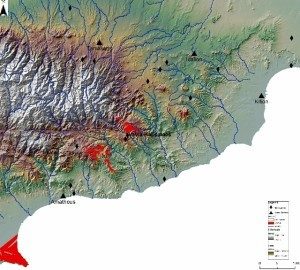Project report by Dr Giorgos Papantoniou, papantog@uni-bonn.de
Previous multi-dimensional approaches to the study of ancient Mediterranean societies have shown that social, economic and religious lives were closely entwined. In attempting to engage with Cyprus’s multiple identities – and the ways in which islanders may have negotiated, performed or represented their identities – several material vectors related to ritual and sacred space must be taken into consideration. The sharp modern distinction between sacred and profane is not applicable to antiquity, and the terms ritual, cult and sacred space in Unlocking Sacred Landscapes: Cypriot Sanctuaries as Economic Units are used broadly to include the domestic and funerary spheres of life as well as formally constituted sanctuaries. Perceiving ritual space as instrumental in forming both power relations and the worldview of ancient people, and taking ancient Cyprus as a case study, the Project aims at elucidating how meanings and identities were diachronically expressed in, or created by, the topographical and economic setting of ritual and its material depositions and dedications.
The evidence of cult or sacred space is very limited and ambiguous before the Late Bronze Age. During the Late Bronze Age (ca. 1700-1125/1100 BC), however ritual spaces were closely linked to industrial activities; the appropriation, distribution, and consumption of various resources (especially copper), labour and land was achieved by the elite through exploitation of supernatural knowledge. The Early Iron Age (ca. 1125/1100-750 BC) landscapes are very difficult to approach. We can, however, identify sanctuary sites in the countryside towards the end of this period. This phenomenon might well relate to the consolidation of the Iron Age Cypriot polities (known in the archaeological literature as Cypriot city-kingdoms) and their territories. While urban sanctuaries become religious communal centres, where social, cultural and political identities are affirmed, an indication of the probable use of extra-urban sanctuaries in the political establishment of the various polities of the Cypro-Archaic (ca. 750-480 BC) and Cypro-Classical (ca. 480-310 BC) periods has recently been put forward.
During the Hellenistic period (ca. 310-30 BC), a process of official neglect of the extra-urban sanctuaries signals a fundamental transformation in the social perception of the land. After the end of the city-kingdoms, and the movement from many political identities to a single identity, extra-urban sanctuaries were important mainly to the local extra-urban population. By the Roman period (ca. 30 BC-330 AD), the great majority of Hellenistic extra-urban sanctuaries are ‘dead’. When the social memory, elite or non-elite, that kept them alive ‘dies’, they ‘die’ with it; what usually distinguishes the surviving sites is what the defunct sites lacked: political scale and significance. As the topography of Roman sanctuary sites reveals, this is not to say that extra-urban sanctuaries did not exist anymore. Over time, however, they started to become primarily the concern of local audiences. The annexation and ‘provincialisation’ of Cyprus, with all the consequent developments, were accompanied by changes in memorial patterns, with less focus on regional or local structures, and more intense emphasis on stressing an ideology which created a more widely recognisable ‘pan-Cypriot’ myth-history, which was eventually related to Ptolemaic, and later to Roman imperial power and ideology.
This Project puts together a holistic, inter-disciplinary approach to the diachronic study of the ancient Cypriot ritual and cult. While it aims at bringing together textual, archaeological, epigraphic, art-historical, and sociological/anthropological evidence, for the first time it incorporates ‘scientific’ spatial analysis and more agent-centred computational models to the study of ancient Cypriot sanctuaries and religion. By inserting in a GIS environment the Cypriot sanctuary sites the relation of sacred landscapes with politico-economic geography put forward above is tested both at regional and at island-wide level.
The Project falls under the umbrella of a larger Research Network entitled Unlocking Sacred Landscapes.
For further information: http://www.ucy.ac.cy/unsala/
Dr Giorgos Papantoniou
Research Training Group 1878: Archaeology of Pre-Modern Economies
Rheinische Friedrich-Wilhelms-Universität Bonn
Institut für Archäologie und Kulturanthropologie
Abteilung für Klassische Archäologie
Lennéstr. 1
D-53113, Bonn
Germany



